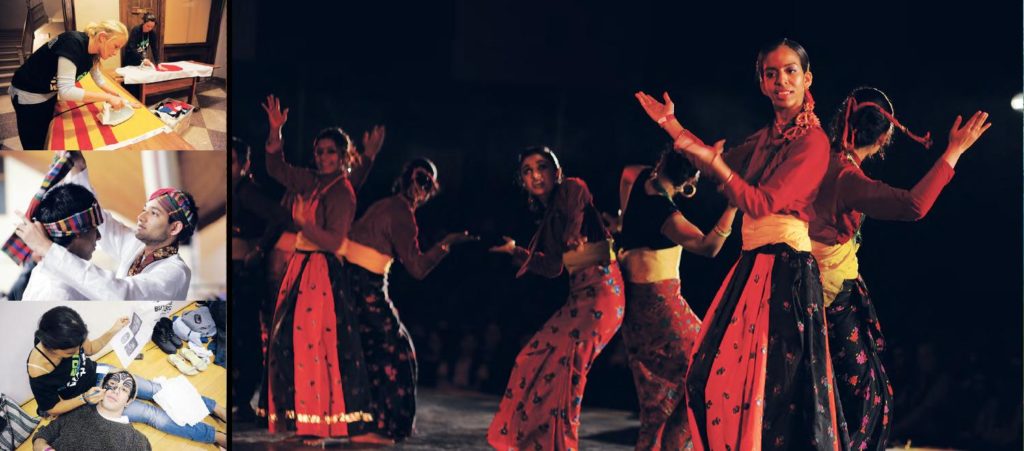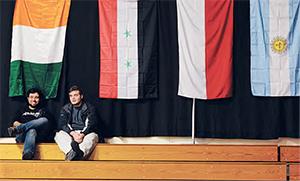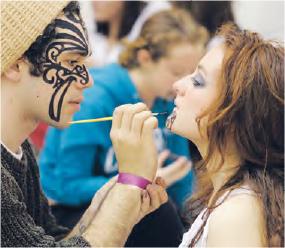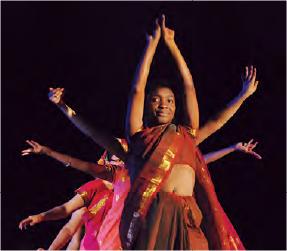
As it hits the 10-year mark, Clark’s International Gala remains a miracle of planning and execution. An insider delivers the low-down on how it’s done.
It’s about 3 a.m. the morning of the show — earlier than I expected to be contemplating the prospect of sleep. Final dress rehearsal wrapped up around 2 a.m. Sound and stage lights have been put to rest by a student crew, and they along with Director of Student Leadership and Programming Mike McKenna (collectively known as Mike’s Team) are preparing to head home.
International Students Association (ISA) members are done with their final checks, which include a last-minute trip to pick up safety pins, resetting the space to opening-night form, and hanging a world’s-worth of flags that proudly decorate the perimeter of the Kneller Athletic Center.
About eight of us are pulling out sleeping bags, sheets and pillows, and making our way to the stage that didn’t even exist 24 hours ago. This will be our soft place to land for the night. We must stay here because the wiring and temperature-sensitive equipment prevent the Kneller doors from being locked, and anyone could walk in. Some stayed behind for the camaraderie of a last night together. I don’t have it in me to point out that they will have to cancel their slumber-party dreams — they will be out before their heads hit the pillows. So I just say my good-nights and demonstrate. We’ve got five hours of quiet time ahead of us. Then, things will move fast and furiously.
I saw Clark’s International Gala long before I landed in Worcester.
My brother, also a Clarkie, would bring a performance DVD home over break and I would watch, enthralled — not so much by the show, but by the sight of my brother bangra-ing and beat boxing, his onstage persona incongruent with my pre-college image of him as more of a backstage, two-left-feet kind of person. Yet, I would soon learn, that’s the thing about Gala: It transforms.
My first taste of the show would be, in structure, different from my brother’s. Under Ihar Valodzin ’07, the 2007 show had reached new heights, yet had also grown beyond the seating and backstage constraints of its then-Atwood home. By the time I arrived for the April 2008 edition, Atwood Hall had been reconstituted as our “Hell Week” rehearsal space with new ISA president Shyamal Asher and Mike McKenna initiating the experiment of relocating the Gala performance to the Kneller Athletic Center. Still, despite all the new logistical concerns brought on by the move, the core of the show — its heart and soul-bound performances — retained its passion. This is why seeing the performances take shape each year reminds all involved that it will work even on the most impossible days.

Committing to Gala happens long before the show goes into performance. With so much to do, and so much opportunity for student initiative, Gala allows students to dive into the deep end, contribute meaningfully, and make their mark. That’s what hooked me and what I believe has continued to attract the campuswide involvement on which the show relies. Even though the International Students Association has officially run the event for 10 years, preparing and performing the concert has given us the greatest understanding of how collaborative a project it truly is. The International Gala is a Clark community production.
The day after the curtain falls on the current show, the discussion of the next begins — that’s no exaggeration. Together with Student Leadership and Programming, ISA assesses how well the completed show was managed and budgeted; we note immediate concerns and areas for improvement. Then we set a date.
With other events to attend to in the fall we give the Gala conversation a deliberate rest until late November. Then we press “PLAY.” The International Students Association, which usually boasts some semblance of cohesive structure with committees and specialized positions, then rescinds all boundaries, allowing members to jump around — brainstorming, teamworking, shouting and head-butting. Though the process may seem dysfunctional to the untrained eye, this is how the ever-vibrant and diverse personalities of the ISA executive board get things done. It also fosters an undeniable sense of family.
Our rock, as always, is Amy Daly Gardner, head of the Office of Intercultural Affairs. Since Gala’s inception in 2002, she has helped guide ISA to put on a show that celebrates all forms of diversity on campus while still being incredibly entertaining.
Gala is, for better or worse, cause for our evergrowing team to spend too much time together. There are the usual weekly meetings plus an assortment of new project meetings to attend as we divvy up work on commercial shoots (video and photo), T-shirt design, invitations, flag ceremony organization, stage management, volunteer prep and more. Thankfully, we’ve always found indispensable help from friends. Outsourcing in true globalized style, last year we received assistance from ISA alum Anuj Adhikary ’10, who worked remotely from his Nepalese home to create a signature Gala website that included a promo shot by my best friend Aris Kouvaras ’11 (responsible for four years of great gala videos), and photos by Champo Mapulanga ’12 and Anna Voremberg ’13.
While we all work to build what is essentially the framework for the show, students (and since 2010, geography professor/flamenco dancer Yuko Aoyama) create, teach and perfect show-stopping national and regional performances over a period of weeks and days. Costumes and props are sometimes shipped in or gathered straight from the source over December break. These extra touches not only highlight pride in presentation but imbue a performance with a kind of authenticity a As it hits the 10-year mark, Clark’s International Gala remains a miracle of planning and execution. An insider delivers the low-down on how it’s done.
It’s about 3 a.m. the morning of the show — earlier than I expected to be contemplating the prospect of sleep. Final dress rehearsal wrapped up around 2 a.m. Sound and stage lights have been put to rest by a student crew, and they along with Director of Student Leadership and Programming Mike McKenna (collectively known as Mike’s Team) are preparing to head home. International Students Association (ISA) members are done with their final checks, which include a last-minute trip to pick up safety pins, resetting the space to opening-night form, and hanging a world’s-worth of flags that proudly decorate the perimeter of the Kneller Athletic Center.
About eight of us are pulling out sleeping bags, sheets and pillows, and making our way to the stage that didn’t even exist 24 hours ago. This will be our soft place to land for the night. We must stay here because the wiring and temperature-sensitive equipment prevent the Kneller doors from being locked, and anyone could walk in. Some stayed behind for the camaraderie of a last night together. I don’t have it in me to point out that they will have to cancel their slumber-party dreams — they will be out before their heads hit the pillows. So I just say my good-nights and demonstrate. We’ve got five hours of quiet time ahead of us. Then, things will move fast and furiously.
I saw Clark’s International Gala long before I landed in Worcester.
My brother, also a Clarkie, would bring a performance DVD home over break and I would watch, enthralled — not so much by the show, but by the sight of my brother bangra-ing and beat boxing, his onstage persona incongruent with my pre-college image of him as more of a backstage, two-left-feet kind of person. Yet, I would soon learn, that’s the thing about Gala: It transforms.
My first taste of the show would be, in structure, different from my brother’s. Under Ihar Valodzin ’07, the 2007 show had reached new heights, yet had also grown beyond the seating and backstage constraints of its then-Atwood home. By the time I arrived for the April 2008 edition, Atwood Hall had been reconstituted as our “Hell Week” rehearsal space with new ISA president Shyamal Asher and Mike McKenna initiating the experiment of relocating the Gala performance to the Kneller Athletic Center. Still, despite all the new logistical concerns brought on by the move, the core of the show — its heart and soul-bound performances — retained its passion. This is why seeing the performances take shape each year reminds all involved that it will work even on the most impossible days.

Committing to Gala happens long before the show goes into performance. With so much to do, and so much opportunity for student initiative, Gala allows students to dive into the deep end, contribute meaningfully, and make their mark. That’s what hooked me and what I believe has continued to attract the campuswide involvement on which the show relies. Even though the International Students Association has officially run the event for 10 years, preparing and performing the concert has given us the greatest understanding of how collaborative a project it truly is. The International Gala is a Clark community production.
The day after the curtain falls on the current show, the discussion of the next begins — that’s no exaggeration. Together with Student Leadership and Programming, ISA assesses how well the completed show was managed and budgeted; we note immediate concerns and areas for improvement. Then we set a date.
With other events to attend to in the fall we give the Gala conversation a deliberate rest until late November. Then we press “PLAY.” The International Students Association, which usually boasts some semblance of cohesive structure with committees and specialized positions, then rescinds all boundaries, allowing members to jump around — brainstorming, teamworking, shouting and head-butting. Though the process may seem dysfunctional to the untrained eye, this is how the ever-vibrant and diverse personalities of the ISA executive board get things done. It also fosters an undeniable sense of family.

Our rock, as always, is Amy Daly Gardner, head of the Office of Intercultural Affairs. Since Gala’s inception in 2002, she has helped guide ISA to put on a show that celebrates all forms of diversity on campus while still being incredibly entertaining.
Gala is, for better or worse, cause for our evergrowing team to spend too much time together. There are the usual weekly meetings plus an assortment of new project meetings to attend as we divvy up work on commercial shoots (video and photo), T-shirt design, invitations, flag ceremony organization, stage management, volunteer prep and more. Thankfully, we’ve always found indispensable help from friends. Outsourcing in true globalized style, last year we received assistance from ISA alum Anuj Adhikary ’10, who worked remotely from his Nepalese home to create a signature Gala website that included a promo shot by my best friend Aris Kouvaras ’11 (responsible for four years of great gala videos), and photos by Champo Mapulanga ’12 and Anna Voremberg ’13.
While we all work to build what is essentially the framework for the show, students (and since 2010, geography professor/flamenco dancer Yuko Aoyama) create, teach and perfect show-stopping national and regional performances over a period of weeks and days. Costumes and props are sometimes shipped in or gathered straight from the source over December break. These extra touches not only highlight pride in presentation but imbue a performance with a kind of authenticity and traditional glamour — such as the Bolivian masks and spears that graced the stage in 2009, or the swirling, glistening sarees that highlight the India performance.
Our now 300-plus performers give up their weekends and free time between classes to rehearse tirelessly in any makeshift practice space that can be found — which has been known to include the Johnson and Dodd Hall basements, the Kneller squash courts, the abandoned floor of an off-campus house, the Kneller and Atwood lobbies, and even the concrete courtyard outside Atwood. And it’s they, with much-appreciated patience, who bear with the organizers as we ask them to stay in poorly ventilated, belowground- level squash court “dressing rooms” on show night and line up along the pool deck while anxiously awaiting their turn to perform. For this they are rewarded by staying behind to dismantle the bleachers and stage only minutes after their well-deserved curtain call.
On show night, the performers’ comings and goings are orchestrated by a varying four- to six-person “host” team. This rigorously auditioned, practiced and advised group carries the weight of representing all of what the show is about, usually while being asked to keep it tightly timed and appropriate. It’s a tough gig subjecting yourself to being the man or woman in this particular arena. You’re open to much criticism and exhaustion, but it can be a prized challenge that reaps at least a week’s worth of adulation from those who think you got it right.
We also boast an incredible group of volunteers who jump on board with no intention of taking the stage. They come solely to fill vital, but perhaps more off-radar, positions such as security and ushers. The stage builders join ISA and Mike’s Team in the week leading up to the performance to unload three trucks of staging, sound and light equipment on Wednesday evening, build the stage till around midnight, and then return at 6:30 a.m. on Thursday to help assemble bleachers in time for the 3 p.m. tech rehearsal — often solely on the promise of coffee, donuts and entrance to the show.
While we stand in awe of our fellow Clarkies through all of this, nothing compares to knowing that the wider Clark community does as well. There are the professors who patiently bear with half-functional students shuffling into class after too-long rehearsals, and faculty and staff who attend to cheer on their pupils, student interns and even their own children. High school teacher Nellie Maley ’08, M.A.T. ’09, has brought her students to Gala for the past two years to help them experience her alma mater.
Family and friends arrive from all over on show night, some traveling from out of state, and at least one from outside the continent. In 2010, the parents of Terrance Ma ’11 flew in from China to see for themselves the moment when Gala participants become something our often quiet, awkward, eccentric or merely nervous selves didn’t know we could be. Behind the scenes, or under spotlights, but with audience support unfolding before us — we transform.
The 8 a.m. wake-up is conducted by Mike McKenna. Appropriate to our basketball-court setting, the knowledge that it’s “game time” gets me up. Members of the ISA reconstitute in the Kneller, as Mike’s Team, Jim Cormier from Media Services, Clark Cable Network members who are here to tape the show, all the volunteers, and of course, the performers, roll in for the last push.
As evening approaches there will be a few more anxious moments as videos require last-minute reformatting and performers anxiously await their time on stage. Yet all the while I breathe, feeling calmer than anticipated. In the last few days I had decided, as I watched my ISA family and our friends prepare the three-hour show to come, that the night would manifest itself as we all deserved it to — spectacularly.
The calendar reads April 1, but outside, Clark has been blanketed by an unseasonal yet beautiful snowshower. Even Mother Earth seems to have set her stage for some magic to happen.


